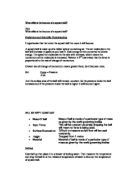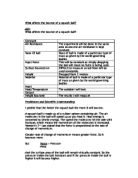Say that the two circles were eyes, and they were both reading the bounce of that particular ball,
then they’d both have read it from different angles
and therefore had gotten different results.
For that reason, the eye level has to be consistent.
Ball
Metre stick
We will communicate our results by using a table, and also displaying them on a graph. This will help us see any anomalies or faults within the experiment, and let us make changes or amendments where appropriate.
Equipment:
Squash ball- we will keep the same squash ball throughout the experiment in order to keep it a fair test.
Tape measure- to measure the height from which we drop it.
Metre stick- to measure the bounce of the ball
Variables:
Measured: How high the squash ball bounces
Changed: The height the squash ball is dropped from
Controlled: The ball, the temperature of the ball, the surface, the people, the force the ball is dropped with.
Prediction:
I predict that the higher the ball is dropper from, the higher it will bounce. This is because when a ball is dropped from a higher height, it has much more gravitational potential energy than if it is dropped from a lower one. Therefore all this gravitational potential energy can be converted into kinetic energy, allowing it to bounce higher. As well as this, when a ball is dropped from a higher height, the ball is compressed more when it comes in contact with the ground, and therefore the compressed air can again make it bounce back higher.
Preliminary work
We did some preliminary work in order to see what we could do to improve our experiment, as well as see where changes should be made. Below are the results.
T E S T N U M B E R (cm)
Although the results were accurate, we decided a few changes had to be made.
Firstly, we decided not to drop from such low heights. This is because the bounce was very low, and we couldn’t read it very well. This made the results quite inaccurate as to get very accurate results for such a low bounce height, we’d have to have gotten it to about three decimal places.
We also decided to drop the ball four times not three. This was so that we could gain more accurate results. We wouldn’t use the first result when considering the average though as it was only an estimate as to where the ball would bounce. As well as this, just in case we had odd results we would obtain another two set of results, to see if we had done it incorrectly or if it was just a random result.
We would also round each result to 0.5cm so that it was easier to compare results.
Results table 1
T E S T N U M B E R (cm)
* not considered when working out average.
We did the experiment, but as you can see the results weren’t very good. This was either because the ball was dropped from slightly different heights or maybe they were read inaccurately when the reading was done. As they were quite inaccurate, we decided to do the experiment again, to gain more accurate results. We did not change anything though.
Results table 2
T E S T N U M B E R (cm)
Below is a graph of our first experiment. As you can see there are many anomalies, and quite a few errors occurred, which we then corrected in the second experiment.
Conclusion
From my results, I found that as the height that the squash ball increases, so does the bounce height. This is for a few reasons.
The first one is because of the gravitational potential energy. When dropped from a higher height, the ball gains more gravitational potential energy which means that when it hits the floor it can turn into kinetic energy, allowing it to bounce back higher than when it is dropped from lower down.
As well as this, when dropped from higher, the ball is compressed more then from if you’d drop it from lower down, allowing it to bounce back higher. Though this may happen, I believe there will be a point or a limit at where it would stop, as if this were the case then it could bounce x amount of metres, which it can’t.
Another factor that may have accidentally arisen is that the ball may have heated up during the experiment, making the particles inside it move much faster and therefore the ball will bounce back higher. This though shouldn’t really have happened in our experiment and was a fault if it did, and I shall explore it in the evaluation.
The results show approximately that every 0.5 metre that you go up, the ball bounces another 10cm. This seems quite right as the kinetic energy of a squash ball is directly proportional to the height which it is dropped from, therefore it would go through (0,0), which our graph shows does happen.
This shows that there is a pattern. Not an obvious or great one, but you can just about see the bounce height going up in stages as you drop it from greater heights.
The results fit my prediction quite well, though I failed to comment accurately on what I’d think would happen. The squash ball did bounce back higher when it was dropped from a greater height, yet I failed to spot that there would be any kind of pattern.
On the graph below, you can see there is only one anomaly highlighted, which shows the accuracy of this experiment. You can see the pattern fall into place as we see a line of best fit, which fits in very well. The anomaly probably came in due to a reading error of some sort. It’s doubtful that it was due to an odd result, and therefore it must have been a reading error.
As you can see, the line is quite a good one. Approximately every 0.5 metres, the ball bounces another 8-10cm. These results are quite consistent. This shows that our results were quite accurate and consistent.
Evaluation
We found that our results were quite accurate. They fitted in with the laws of physics that we explored, as well as generally being quite well done.
I believe that the way we conducted our experiment was sufficient for the amount of equipment that was available to us. As well as this, we were exploring a wide range of data, the results were consistent, and as we saw had a pattern showing that they were probably correct. They also matched the prediction that I put forward. The quality of the evidence was quite high, as you can see. We only had one anomaly, which may seem perhaps inaccurate yet was a great improvement from our first experiment.
However, we could have probably been a bit more accurate. The experiment was suitable to the question in hand, yet certain improvements could have been made.
Firstly we could have dropped the ball from a more definite height, making it more accurate. For our experiment, we were standing at the top of some stairs and we only roughly got the height that we wanted, and it could have been a bit out. Having done this, it might have eliminated the chance of having any anomalies.
We could have also perhaps had two people reading the measurements, so that we got a more accurate answer, not just the point of view from the one person. As well as having two people taking down readings, we could have one at a different angle, as I explored earlier, taking the average and then finding the height of the ball, nearly exactly.
Perhaps we also could have had some sort of temperature control so that the ball didn’t heat up too much and make the experiment less unfair.
We could have also used a recording device in which we recorded the bounce and we could watch it a few times over in order to get accurate results.
The evidence seemed to be quite reliable, yet perhaps a little inaccurate. The fact that it was read by eye made it quite inaccurate, yet it was still reliable as it was quite a relevant procedure that we did. When deciding how reliable something is, you must also take into account the things within it that went wrong.
There are quite a few things we could have done to further the work and provide more accurate results.
Firstly, we could have repeated the experiment once again. Looking at the two set of results that we gained, they’re quite different. Who’s to say that the second set of results was correct and the first one wasn’t.
We could have used a light or a sound sensor, to make it more accurate, as well as seing how accurate we were, and being able to tell if the evidence given by us is in fact reliable.
We could have used different balls, as well as changing the people doing it, gathering information from different points of views. We could have also repeated the experiment in a vacuum so that there would be no air resistance.








